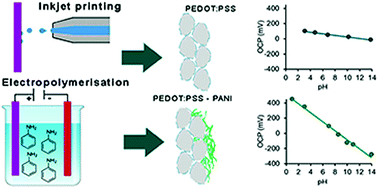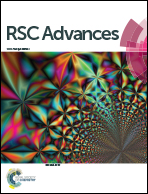Preparation and characterisation of transparent and flexible PEDOT:PSS/PANI electrodes by ink-jet printing and electropolymerisation
Abstract
Novel flexible PEDOT:PSS/PANI bilayered thin-film electrodes were successfully prepared by ink-jet printing of PEDOT:PSS on a PEN substrate and subsequent electrochemical polymerisation of PANI. Scanning electron microscopy (SEM), cyclic voltammetry (CV) and electrochemical impedance spectroscopy (EIS) were used to systematically investigate the structure, morphology and electrochemical behaviour of the electrodes. The PEDOT:PSS/PANI bilayer nanofilms have been tested as pH sensors. As a comparison, either PEDOT:PSS or PANI electrodes have been tested for pH measurements. The results show that the sensitivity of the PEDOT:PSS/PANI bilayer film is higher than that of PEDOT:PSS and PANI electrodes, indicating a synergistic effect of the two polymers. A reversible near-Nerstian behaviour of the open circuit voltage with pH was found, with a slope of 58.9 mV pH−1 unit in a wide range of pH values from 2 to 14.


 Please wait while we load your content...
Please wait while we load your content...